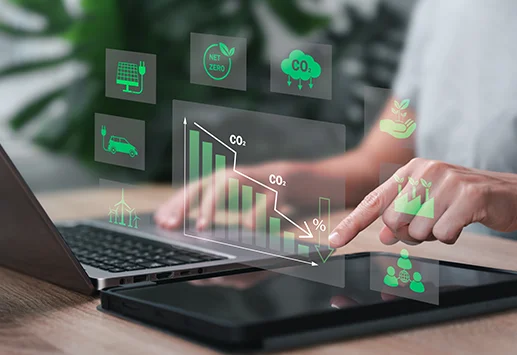Calculate your CO₂

Sustainability isn’t just a buzzword; it’s a shared responsibility to do everything possible to protect the planet for future generations. As ACORN is committed to reducing our CO₂ emissions by 50% by the year 2030, we actively work with our suppliers to offer customers CO₂-reducing solutions.
It’s crucial for all in the supply chain to align practices accordingly; one of the most effective ways to contribute is by accurately calculating and reducing our carbon footprint. By making informed procurement decisions and understanding emissions across a product’s lifecycle, businesses can support their own sustainability goals with data-driven insights.
Using tools such as the Schaeffler CO₂ tool can help companies measure and understand their products' carbon impact. It doesn’t just show your current footprint; it also helps you identify how much CO₂ you can save by choosing more efficient solutions.
But how does it work?
This powerful tool uses product-specific analysis to calculate the product carbon footprint for specific components or systems across their full lifecycle, stretching from raw material extraction to manufacturing, use, and disposal.
Try the tool here (opens new window)
Remanufacturing – save CO₂ with existing products
One of the ways you can positively impact a product's CO₂ lifecycle is through remanufacturing. This is particularly effective for large-sized bearings and specialist equipment such as ball-screw drives. By remanufacturing existing products, not only do you reduce waste products, but you can save tonnes of CO₂ whilst also significantly reducing costs compared to buying new.
However, remanufacturing must be undertaken before component failure or before damage is irreversible. This means that monitoring the condition of components is essential for both maintenance and CO₂ costs.
See how much a large paper manufacturer saved in cost and CO₂ with remanufacturing
Data-driven CO₂ tracking
It’s always best to make any business decisions based on solid data. While product-level decisions are critical, energy efficiency at the operational level can also drive major sustainability gains. That’s why monitoring the CO₂ footprint of components is critical, so users can see where savings can be made throughout their operations.
That’s where Power-Adapt, Schaeffler’s energy monitoring system comes into play. The Power-Adapt energy monitoring system is designed to measure, record and analyse energy consumption from machinery, production lines, and entire facilities, giving users visibility into emissions at an operational level. The system enables users to identify energy spikes, idle-time usage, and unusual consumption patterns through trend analysis and automated alerts.
Unmonitored energy use is one of the biggest hidden contributors to unnecessary CO₂ emissions. Tools such as the Power-Adapt illuminate exactly where energy is going and where it shouldn’t be, cutting emissions and energy costs for businesses.
Working together towards a greener future
Reducing CO₂ emissions isn’t just about long-term strategy; it’s about the everyday decisions we make with the tools and data available to us. Whether it’s remanufacturing to extend the life of high-value components or using real-time energy monitoring to cut waste and improve efficiency, these actions all contribute to meaningful, measurable improvements. Tools like the Schaeffler CO₂ tool and power-adapt empower businesses to move from intention to action, giving us all a clearer path to lower emissions.
At ACORN, we’re proud to support our customers with practical, innovative solutions that make sustainability achievable. Because when we each take responsibility, the entire supply chain benefits. Contact our product experts today about emission-conscious product selection.
